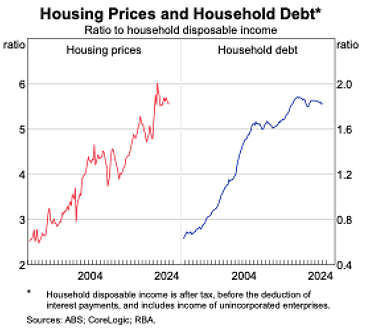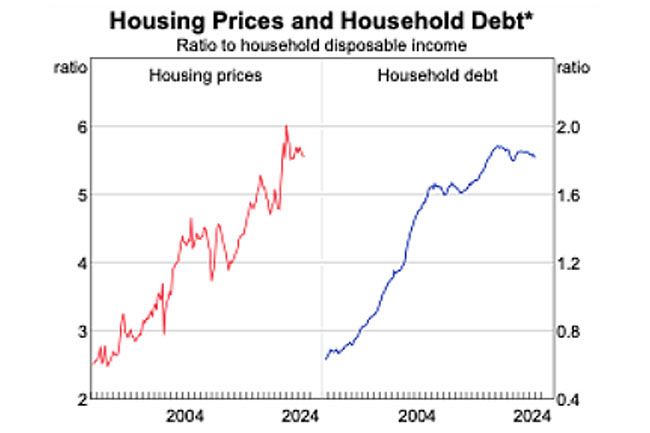The economy is a dominant issue in the Election. From now until polling day, Independent Australia will outline some key facts on the economy that put the kybosh on many of the myths, lies and distortions being peddled in the election campaign.
This is the twelfth in a series of short articles by leading economist Stephen Koukoulas, which will be published daily up until the Federal Election on Saturday 3 May 2025.
FACT TWELVE: IS HOUSING AFFORDABILITY ALREADY IMPROVING?
One widely used measure of housing affordability is the ratio of house prices to household disposable income.
After each meeting of its Board, the Reserve Bank of Australia (RBA) publishes this ratio in its Chart Pack, which incorporates updated information on incomes and house prices
The latest version of the chart is reproduced below. It shows that the house price to household income ratio has risen markedly from the 1980s (the starting date for the chart). Included in this broad trend of higher house prices relative to household incomes are periods where the ratio stabilises or falls before resuming its upward trend.
The periods of flat to downward moves in the ratio are because household income growth exceeds house price growth over that time.

In the most recent period, since hitting a record high of 6.0 in 2020-21, the ratio has fallen to 5.5 as house price growth has moderated and the growth in household incomes has risen.
To be sure, this is not necessarily a claim that housing is all of a sudden “affordable”, but what it does show is that housing affordability can be improved with a sustained rise in household incomes relative to weaker house price growth.
In other words, sharp falls in house prices, which would likely present serious problems for the economy, are not needed to restore housing affordability.
Indeed, at a macroeconomic level, this is the least disruptive way to improve affordability.
By way of example, if over the next five years household disposable income grows by 5.5% per annum while house prices rise 2% per annum, the ratio of house prices to household income would fall to 4.5%, where it was around 2005 (the author’s calculations). This is back to levels seen 20 years ago.
As Housing Minister Clare O’Neil noted, house prices do not have to fall to improve affordability. The recent experience supports this and as the supply of dwellings surges in the next two years, it is reasonable to expect better affordability.
Just the facts.
Other facts in this series:
- #1: In fact, Labor has inflation back under control
- #2: Energy prices are plummeting
- #3: Wage growth on the rise under Labor
- #4: Labor brought down government debt by billions
- #5: Labor building on a better future
- #6: Coalition taxing at a record high, not Labor
- #7: Under Labor, Australia is more productive
- #8: Australia among best in the world at beating inflation
- #9: Australia keeping tax down
- #10: Employment rising under Labor
- #11: Interest rates expected to drop under Labor
Stephen Koukoulas is one of Australia’s most respected economists, a past chief economist of Citibank and senior economic advisor to an Australian Prime Minister. You can follow Stephen on Twitter/X @TheKouk.
Support independent journalism Subscribe to IA.
 This work is licensed under a Creative Commons Attribution-NonCommercial-NoDerivs 3.0 Australia License
This work is licensed under a Creative Commons Attribution-NonCommercial-NoDerivs 3.0 Australia License

Related Articles
- Many critical values at stake in Saturday’s election
- 'Game on' as the 2025 Election battle escalates
- AUSVOTES ECONOMIC FACTS #11: Interest rates expected to drop under Labor
- Racism absent from Coalition election campaign
- AUSVOTES ECONOMIC FACTS #10: Employment rising under Labor











